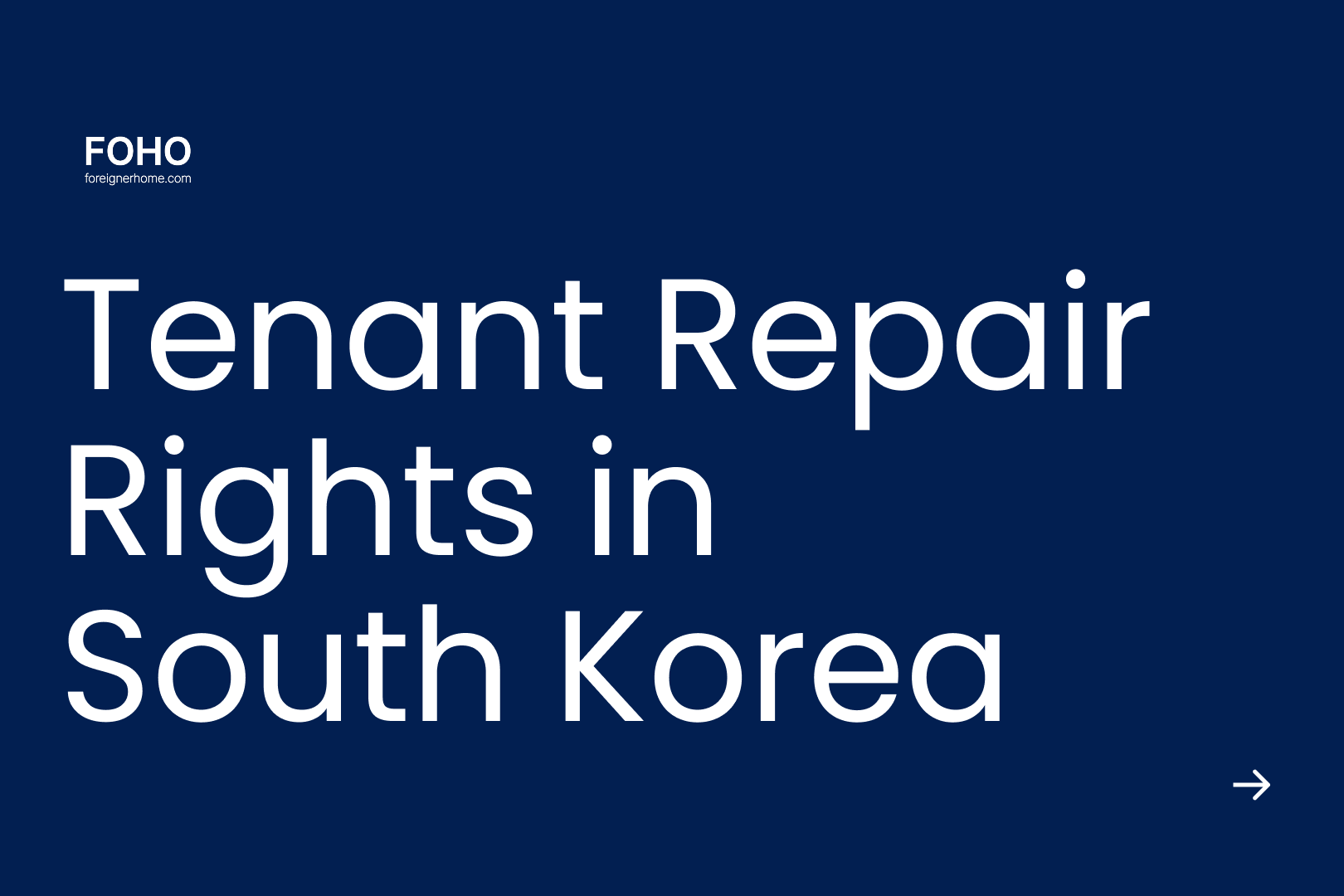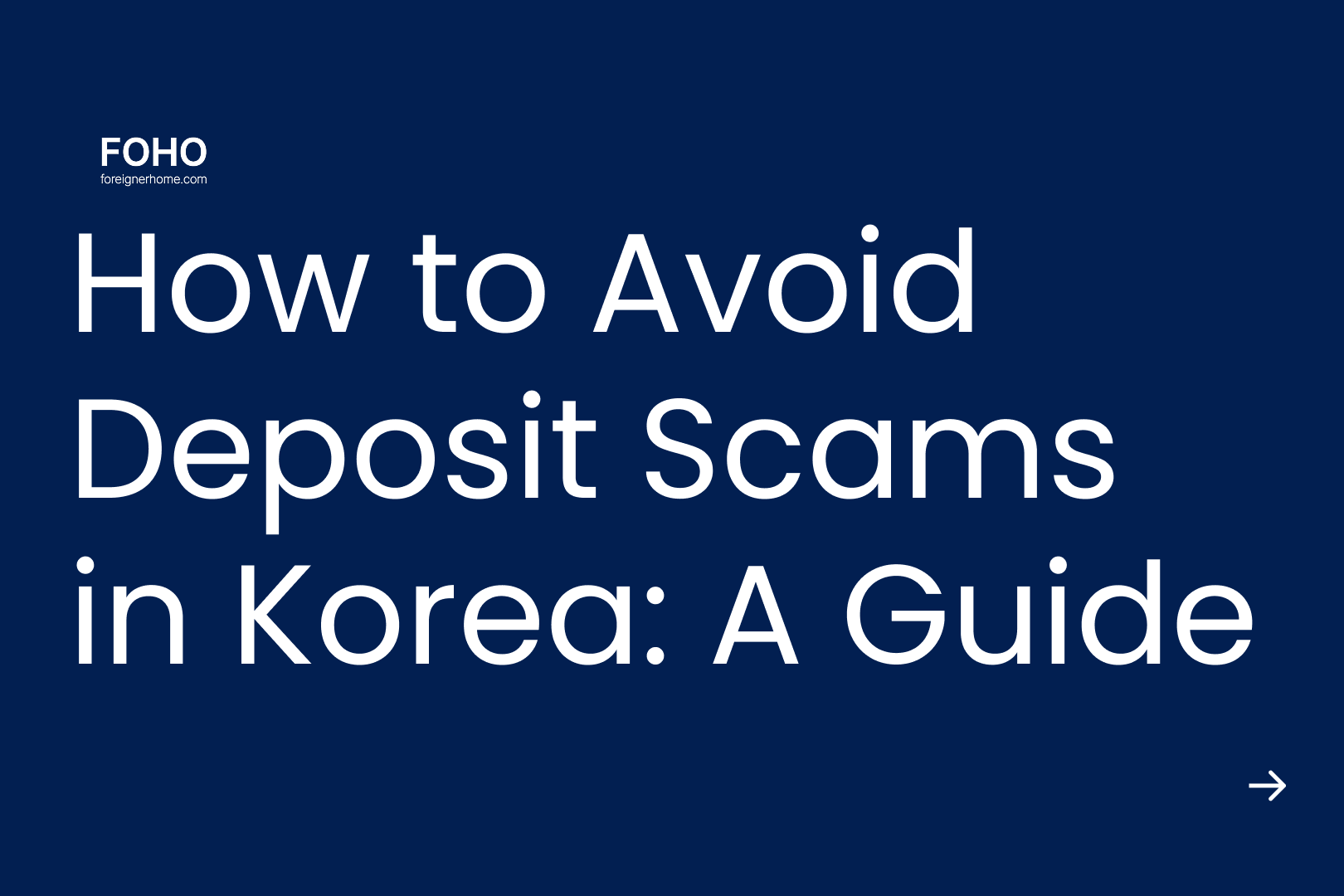FOHO Blog – Global Housing & Living Guide for Foreigners
Your Guide to Tenant Repair Rights in South Korea
Facing housing problems in Korea? This guide for foreign tenants explains landlord repair duties and how to solve issues like leaks or broken boilers.

Table of contents
- 01Something Wrong with Your House? A Complete Guide for Foreigners on Solving Housing Issues in Korea
- •1. Who is Legally Responsible for Repairs? (Landlord vs. Tenant)
- •2. A Problem Occurs! Your 4-Step Action Plan
- •3. When Communication Fails: Where to Get Help
- •Conclusion: Know Your Rights and Act Wisely
Something Wrong with Your House? A Complete Guide for Foreigners on Solving Housing Issues in Korea
1. Who is Legally Responsible for Repairs? (Landlord vs. Tenant)
The Landlord's Core Duty: Article 623 of the Civil Act
Korean Civil Act, Article 623 (Lessor's Duties) A lessor is obligated to deliver the object to the lessee, and to maintain it in a state necessary for its use and profit-making throughout the duration of the lease.
The Tenant's Duties: "Duty of Care" and "Duty to Notify"
Landlord's Responsibility vs. Tenant's Responsibility: Specific Cases
🏠 Landlord's Responsibility: Major Facilities & Deterioration
- Core Facilities: Boiler, water/gas pipes, electrical wiring, building pillars, structural wall cracks—anything essential for living.
- Structural Issues: Water leaks, severe mold from condensation due to poor insulation (gyeolro), and problems with the building's exterior.
- Built-in Options: Malfunctions of pre-installed appliances like air conditioners, washing machines, refrigerators, or induction stovetops due to normal aging (as long as you did not break them).
- Safety-Related: A broken door lock (due to age or defect), a torn insect screen (from normal wear), or issues with the main entrance door.
👤 Tenant's Responsibility: Consumables & Damage You Caused
- Simple Consumables: Replacing light bulbs, remote control batteries, or door lock batteries.
- Damage from Negligence: A window you accidentally broke, excessive nail holes in the wall, or wallpaper/flooring damaged by a pet.
- Neglect of Daily Upkeep: Minor mold caused by poor ventilation, or a clogged toilet/sink drain due to food waste or hair.
"The Power and Limits of Special Contract Clauses"Your lease may contain a special clause (teukyak) stating, "The tenant is responsible for minor repairs." While this clause is legally valid, Korean courts interpret its scope very narrowly. This means that even with such a clause, major repairs like replacing a boiler or fixing a serious leak remain the landlord's responsibility. Don't let a contract clause bully you into accepting unfair charges.
2. A Problem Occurs! Your 4-Step Action Plan
Step 1: Document Everything (Crucially Important!)
- Take Photos and Videos: Clearly capture the problem area from multiple angles. (e.g., the boiler's error code, the exact spot of the leak, the full extent of the mold). Using a timestamp app on your phone to show the date and time is even better.
- Keep a Log: Write down when the problem started and what inconveniences it's causing. A simple dated memo is sufficient.
Step 2: Officially Notify Your Landlord
- Use Text Messages or KakaoTalk, Not Phone Calls: The conversation history is saved automatically, serving as clear proof of when and what you reported.
- Be Clear and Polite: Describe the situation concisely and factually, avoiding emotional language. Objective facts are more effective than pleas.
[Sample Repair Request Message]English: Hello, this is [Your Name], the tenant of [Apt/Villa Name, Unit #]. I am writing to inform you that there is a [water leak] from the [ceiling in the master bedroom]. Please visit to check the condition when you are available and arrange for prompt repairs. I have attached photos for your reference. Thank you.Korean (for reference): 안녕하세요, [아파트/빌라 이름 및 호수]에 거주하는 임차인 [이름]입니다. 다름이 아니라, [안방 천장]에서 [물이 새고 있습니다]. 생활에 불편이 있어 연락드렸습니다. 시간 괜찮으실 때 방문하시어 상태를 확인해 주시고, 조속한 수리를 부탁드립니다. 관련 사진을 첨부합니다. 감사합니다.
Step 3: Arrange Repairs and Settle Costs
- What if the landlord doesn't respond or delays the repair?
- After waiting a reasonable amount of time (e.g., a few days), send a follow-up message to state your intentions clearly.
- Example: "Hello, it has been several days without hot water due to the broken boiler, which is causing significant hardship. If no action is taken by tomorrow, I will arrange for the repair myself and claim the cost. I will deduct the repair fee from this month's rent."
- This is your legal right (right to claim necessary expenses), but it should be used as a last resort and with caution.
- Receipts are Essential: After the repair is complete, you must keep the receipt or have a bank transfer record to claim the cost.
Step 4: Communicate Smoothly to Prevent Disputes
- Be Respectful: In Korea, it's common to address a landlord as sajangnim (사장님), which is a general term of respect. A polite attitude can go a long way in solving problems.
- Communicate Clearly: Instead of saying, "This is so inconvenient," state the facts: "Error code 07 is showing, and I cannot take a shower because there is no hot water."
3. When Communication Fails: Where to Get Help
Housing Lease Dispute Mediation Committee (HLDMC)
- Benefits:
- Speed: Cases are typically concluded within 60 days.
- Low Cost: Fees range from just ₩10,000 to ₩100,000, depending on the amount in dispute.
- Legal Power: If both parties accept the mediation proposal, it has the same legal force as a final court judgment.
- How to Apply:
- You can apply online or by visiting a local committee office.
- You will need a copy of your lease contract and your evidence (photos, text message history, etc.).
- Contact: Dial 132 (without an area code) to reach the Korea Legal Aid Corporation, which can guide you to the nearest committee office.
Additional Support for Foreigners
Organization Name | Contact | Key Services | Website |
Danuri Helpline | 1577-1366 | 24/7 three-way interpretation services (13 languages) and general information. Connects an interpreter to your call with the landlord. | www.liveinkorea.kr |
Seoul Global Center | 02-2075-4180 | Free professional counseling on housing, labor, and legal issues for foreigners in Seoul (multilingual support). | global.seoul.go.kr |
Korea Legal Aid Corp. | 132 | Free legal counseling for everyone. Provides litigation support if you meet certain income criteria. | www.klac.or.kr |
Conclusion: Know Your Rights and Act Wisely
Glossary
- Imdaein (임대인): Landlord or Lessor.
- Imchain (임차인): Tenant or Lessee.
- Suseon-uimu (수선의무): The landlord's legal "duty to repair and maintain" the property in a usable condition.
- Teukyak (특약): Special clauses or provisions added to a standard contract.
- Piryobi sangwhan-cheonggugwon (필요비 상환청구권): The tenant's right to claim reimbursement for necessary expenses (e.g., urgent repairs) that the landlord was supposed to cover.
- Sajangnim (사장님): Literally "CEO," but commonly used as a polite and respectful term to address a landlord.
Your Partner in Korean Housing, From Start to Finish
Settle in faster with FOHO
Browse more verified listings and message landlords in minutes. Lock in your lease with FOHO's secure payments.
Get Foreigner-Friendly Housing Tips
Get the latest news delivered to your inbox.

Nov 4, 2025
FOHO Launches Foreigner-Focused Rental Insurance
FOHO’s deposit insurance protects foreign tenants in Korea from landlord defaults. Stay safe with clear coverage and fast claims.

Oct 31, 2025
How to Convert E-9 Visa to E-7-4 in Korea
A guide for Vietnamese & Chinese E-9 workers in Korea. Learn the E-7-4 visa points system, F-2 requirements, and compare GME vs. Sentbe for remittance.

Oct 30, 2025
How to Avoid Deposit Scams in Korea: A Guide
Avoid deposit scams in Korea with our step-by-step guide. Learn to check property debt, understand the 'Deung-gibu,' and secure your deposit.

Oct 29, 2025
Korea Mental Health: NHIS Coverage and Costs
Get help with mental health in Korea. This guide for foreigners explains how to use NHIS, find low-cost options, and get medication prescriptions locally.
Subscribe to the FOHO newsletter
Actionable housing insights in your inbox.